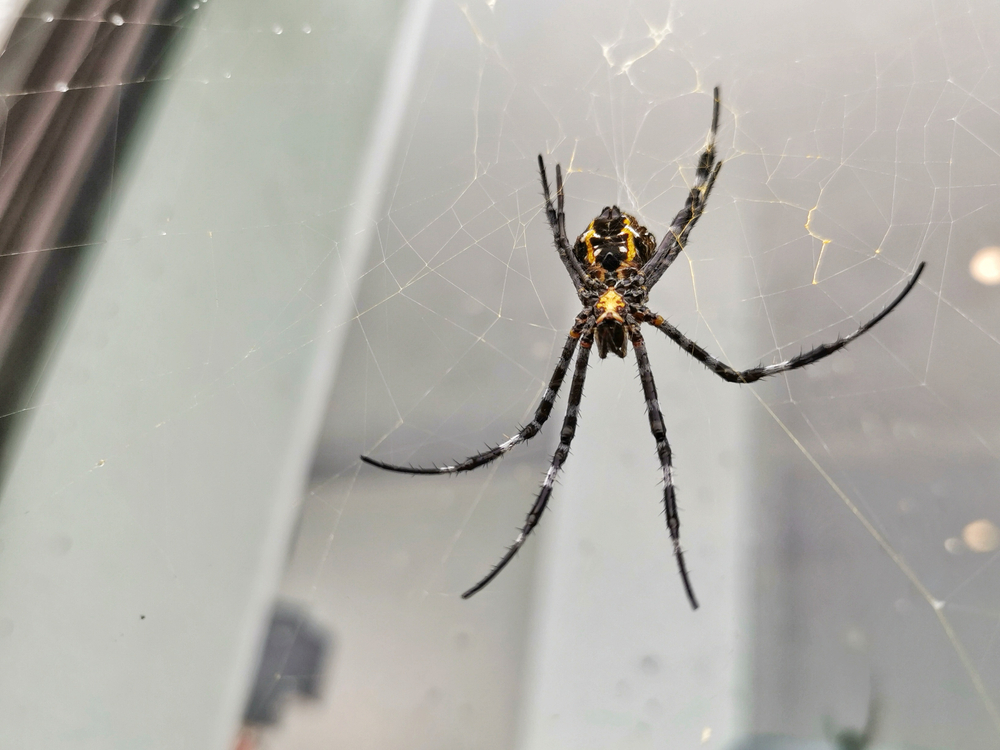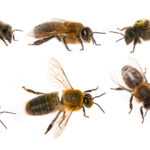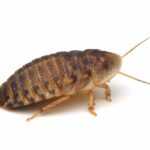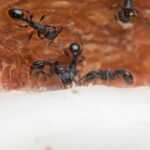Big House Spider: Your Guide to Coexisting with This Harmless Giant
Big house spiders are large, brown spiders often found indoors. Although they may look intimidating, they are harmless and useful for controlling pests. This guide will show you how to identify them, understand their behavior, and deal with them effectively.
- Giant house spiders, identifiable by their dark, hairy bodies and substantial leg span, are harmless and play an essential role in managing indoor pest populations.
- While potentially alarming in appearance, giant house spiders pose low risks to humans, with bites resulting in minor discomfort rather than serious harm.
- Preventing infestations of giant house spiders involves regular cleaning, minimizing clutter, and sealing entry points, alongside the potential use of natural repellents.
Identifying the Big House Spider
Giant house spiders are among the largest spiders you might encounter indoors. They can reach a body length of up to 1.6 cm, with a leg span extending to 7.5 cm, making them quite imposing at first glance. Characterized by their dark, hairy bodies and long legs, these spiders are easily recognizable among other house spiders. Their dark brown color further distinguishes them, helping them blend into the shadows of their preferred habitats.
The scientific name for the giant house spider is Eratigena atrica, previously classified as Tegenaria gigantea.
The typical female leg span can reach up to 7.5 cm, while the male has a slightly smaller body and leg span. The size of the male is highly variable, which can make identification challenging. There are also similar species within the Eratigena complex, and the group is possibly split into multiple species, making accurate identification more difficult.
These spiders can often be found in dark corners, behind furniture, or in basements, where they build their funnel-shaped webs. Despite their large size and somewhat intimidating appearance, giant house spiders are harmless and play a crucial role in controlling pest populations within your home.
Are Big House Spiders Dangerous?
The sight of a giant house spider can be alarming, but it’s important to remember that these giant house spiders are harmless to humans. Most people have nothing to fear from giant house spiders. While they can bite if provoked, their bites are not dangerous and usually result in little more than a mild irritation or a possible allergic reaction. The venom of a giant house spider has little to no toxicity, making them a low threat to human safety.
In most cases, a spider bite from a giant house spider will cause no more than minor discomfort. It’s rare for these spiders to bite unless they feel threatened or cornered, as they prefer to hide or escape rather than bite humans, so interactions with humans are typically peaceful. Understanding this can help alleviate the fear and allow for a more harmonious coexistence with these beneficial arachnids.
Rod Crawford, a well-known arachnologist and expert on spiders, emphasizes that giant house spiders are harmless and actually beneficial because they help control pest populations indoors.
Having giant house spiders around can be advantageous. They help control the population of cockroaches, other pests, and other insects in your home, reducing the need for chemical pest control methods and contributing to a healthier living environment. Recognizing their beneficial role can help you appreciate these spiders’ contribution to maintaining a balanced indoor ecosystem.
Big House Spiders vs. Other Common Spiders
Giant house spiders often get confused with other common spiders due to their size and appearance. However, there are distinct differences that set them apart. Typically, giant house spiders have a solid brown body with long legs, which differentiates them from other spiders that can vary significantly in coloration and size. Their longer legs also make them stand out among other house spiders.
Understanding these differences is crucial for proper identification and for dispelling common myths about these spiders. In the following subsections, we will explore how giant house spiders compare to wolf spiders and hobo spiders, two other species that are frequently encountered in homes.
Big House Spiders vs. Wolf Spiders
Wolf spiders thrive in warmer and drier climates. They are frequently located in outdoor settings. Unlike the giant house spider, wolf spiders do not build webs but are active hunters that roam around in search of prey. They also have a more robust and stocky body compared to the slender build of giant house spiders.
The appearance of wolf spiders can vary widely, often featuring patterns and colors that help them blend into their natural surroundings. While both species can bite humans, wolf spiders are more likely to be encountered outdoors, whereas giant house spiders are commonly found indoors, particularly in dark, undisturbed areas like basements and attics.
Big House Spiders vs. Hobo Spiders
Hobo spiders, also known as aggressive house spiders, are another species often mistaken for giant house spiders. The hobo spider tends to be slightly smaller in size compared to giant house spiders, with a less imposing leg span. Despite their name, hobo spiders are not truly aggressive; their tendency to appear as if they are running towards humans is actually due to their poor vision—they are trying to flee rather than confront.
These spiders are often found in similar environments as giant house spiders, such as basements and dark corners. However, their webs are typically less organized and more scattered. The misconception about their aggressiveness can lead to unnecessary fear, but understanding their behavior can help alleviate these concerns.
Habitat and Behavior
These spiders typically inhabit dark corners of homes, especially during autumn when males seek out females. Their webs are frequently constructed in dark corners, behind appliances, in crawlspaces, and between storage boxes, areas with minimal disturbance. These spiders are attracted to quiet, shaded areas, making basements, attics, garages, and houses ideal habitats for them. It is common to see them crossing the floor at night, especially during mating season.
Their behavior is largely influenced by their need for shelter and food. They help control pest populations by preying on various insects such as mosquitoes and fleas, contributing to a cleaner and healthier living environment. Understanding their habitat preferences and behaviors can help you coexist with these beneficial spiders.
Giant house spiders were introduced to British Columbia nearly a century ago and have since become established throughout the Pacific Northwest, including Washington State, where they are now commonly found in residential areas.
Preferred Habitats
Giant house spiders favor environments that provide shelter and darkness, commonly residing in basements and attics. These areas offer the quiet and undisturbed conditions they prefer, allowing them to build their funnel-shaped webs without interference. They are often found behind furniture, in corners, and near heating sources, where they can easily catch their prey.
These spiders are also drawn to dark areas with minimal human activity, such as behind appliances and in crawlspaces. Their preference for dark, secluded spots helps them stay hidden, reducing the likelihood of encounters with humans and pets.
Keeping these areas clean and uncluttered minimizes the likelihood of encountering these spiders and bed bugs in your home.
Mating Season and Life Cycle
The mating season for giant house spiders occurs in the late summer and early autumn, when males become more active in their search for females. During this time, you may notice an increase in spider activity as males leave their webs and roam around looking for a mate. This seasonal behavior is temporary and typically subsides once the mating season is over.
Female giant house spiders may consume their mates after breeding, a behavior common among many spider species. The life cycle of these spiders can span several years, with females often living longer than males. Knowing their mating season and life cycle aids in anticipating and managing their presence.
Benefits of Having Big House Spiders
Having giant house spiders in your home can actually be beneficial. These spiders primarily hunt ants, roaches, bedbugs, flies, and earwigs, helping to keep your home free of these unwanted pests. Controlling pest populations, giant house spiders help maintain a cleaner, healthier living space.
Their presence can reduce the need for chemical pest control methods, which can be harmful to both humans and pets. Additionally, giant house spiders’ longer legs allow them to navigate various surfaces effectively, increasing their efficiency in catching prey.
Embracing these spiders as natural pest controllers can lead to a more balanced and eco-friendly home.
How to Prevent Big House Spider Infestations
Preventing infestations of giant house spiders involves regular maintenance and cleanliness. Regular vacuuming of corners and furniture helps eliminate spider webs and egg sacs, reducing the chances of an infestation. Minimizing clutter in basements and attics also reduces potential hiding spots for spiders. Some people choose to kill spiders they find indoors, though this is not necessary.
Essential oils such as peppermint and tea tree act as natural repellents, and sealing cracks and entry points with caulk can block spider access. Reducing moisture in spaces like bathrooms can deter spiders, which are attracted to damp environments.
Professional Pest Control
Persistent infestations may require professional help. They can help rid your home of spiders, termites, and other pests.
Giant house spiders, despite their intimidating size, are harmless and beneficial residents in our homes. By identifying these spiders correctly, understanding their behavior, and taking steps to prevent infestations, we can coexist with them peacefully. Their role in controlling pest populations is invaluable, contributing to a healthier living environment.
For those who find it challenging to manage these spiders on their own, professional help is always an option. Their expertise in pest management, along with tips on how to help prevent desert recluses, ensures that your home remains safe and comfortable, free from unwanted pests.
Frequently Asked Questions
Are spiders venomous?
Spiders are indeed venomous, as almost all species possess venom glands that allow them to inject toxins. Only a few small families of spiders lack venom, differentiating them from truly poisonous organisms.
How can I prevent giant house spider infestations?
To prevent giant house spider infestations, regularly vacuum, minimize clutter, seal cracks, and reduce moisture in your home. Additionally, consider using natural repellents or consulting professional pest control services for comprehensive solutions.
What are the benefits of having giant house spiders in my home?
Having giant house spiders in your home is beneficial as they effectively control pest populations, including ants and roaches, thereby promoting a cleaner and healthier living environment. Their presence aids in maintaining ecological balance within your household.
How do giant house spiders compare to wolf spiders?
Giant house spiders are characterized by their longer legs and slender build, while wolf spiders are more robust and stocky. Additionally, wolf spiders favor warmer, drier outdoor environments compared to giant house spiders.
What professional services does Las Vegas Pest Control offer?
Las Vegas Pest Control provides comprehensive pest management services, addressing issues related to ants, mice, spiders, roaches, and more. They focus on eco-friendly methods and offer flexible appointments and emergency services.




